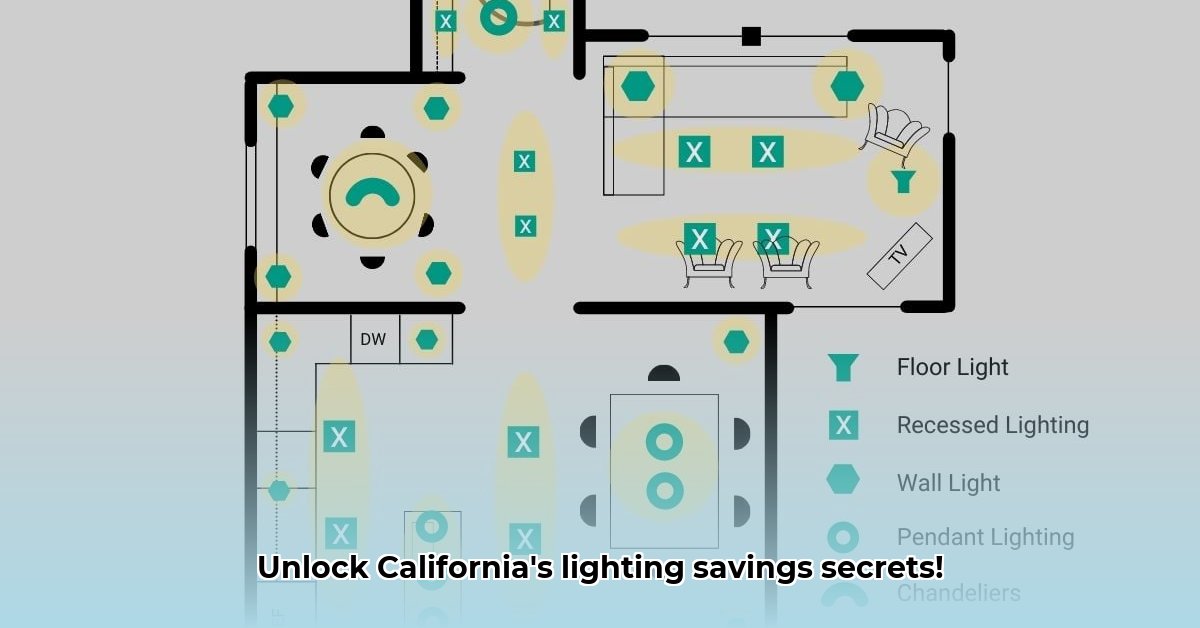
Understanding California's 2022 Lighting Code Requirements
California's 2022 building energy codes (Title 24, Part 6) significantly impact residential and commercial lighting design. These updated regulations prioritize energy efficiency, leading to substantial long-term cost savings and environmental benefits. This guide provides a step-by-step approach to understanding and meeting these requirements. How can you ensure your lighting project complies with these new standards, while minimizing costs and maximizing energy savings? For more information on lighting basics, check out this helpful resource: Learn more about lighting.
A Step-by-Step Guide to Energy-Efficient Lighting Design
This section outlines a six-step process for designing energy-efficient lighting that meets California's 2022 code requirements. Each step incorporates best practices and addresses potential challenges.
Step 1: Assess Your Lighting Needs: Before purchasing any fixtures, thoroughly assess your lighting needs for each space. Consider the intended function of each area and the desired level of illumination (measured in lumens). Don't overestimate lighting requirements; adequate illumination can often be achieved with thoughtful placement and efficient fixtures. A well-lit kitchen requires more lumens than a softly illuminated bedroom. This initial assessment is crucial for cost-effective planning and energy-efficient design.
Step 2: Select Energy-Efficient Lighting Fixtures: LEDs (Light Emitting Diodes) are the most energy-efficient option and are now mandated by code for new construction. When selecting LEDs, consider both lumens (brightness) and color temperature (warmth or coolness of the light). The CLTC (California Lighting Technology Center) provides comprehensive resources and guides for selecting appropriate fixtures. What factors should you prioritize when choosing LEDs?
Step 3: Integrate Smart Lighting Controls: Smart lighting controls, such as dimmers and occupancy sensors, offer significant energy savings and convenience. Smart dimmers regulate brightness based on ambient light and occupancy sensors automatically switch off lights when a room is unoccupied, significantly reducing electricity consumption. How can smart lighting technologies contribute to cost savings and increased comfort?
Step 4: Maximize Natural Light: Design your space to maximize natural light penetration. Strategic window placement and the use of skylights can significantly reduce the reliance on artificial lighting during daylight hours. Effective daylight harvesting minimizes energy consumption and creates a more pleasant living environment. How can you effectively incorporate natural daylighting strategies into your design?
Step 5: Utilize the CLTC Guide and Other Resources: The CLTC provides comprehensive resources, including online calculators and publications, to aid in lighting design compliance. Their materials offer guidance on selecting compliant fixtures, estimating energy savings, and navigating the complexities of Title 24, Part 6. What are some of the key resources available from the CLTC?
Step 6: Engage Professionals When Needed: For complex projects or if you lack experience with electrical work, consider consulting with a qualified lighting designer or contractor. A professional can accurately assess your needs, develop a comprehensive lighting plan that meets the code, and ensure skillful installation. When is it advisable to seek professional assistance for your lighting design project?
Addressing Potential Challenges: A Risk Assessment Matrix
While upgrading to energy-efficient lighting offers significant advantages, certain challenges may arise during the process. The following matrix highlights these potential difficulties and offers practical solutions.
| Technology/Strategy | Likelihood of Problems | Estimated Costs | Projected Savings | Tips for Success |
|---|---|---|---|---|
| LED Lighting | Low | Low | High | Choose reputable brands; ensure proper installation. |
| Smart Lighting Controls | Low | Moderate | Moderate | Start with high-use areas; consider a phased approach. |
| Daylight Harvesting | Low | Moderate | High | Plan carefully; integrate with artificial lighting. |
| Retrofitting Older Homes | Moderate | High | Moderate | Explore rebates and incentives; prioritize cost-effective upgrades. |
"Retrofitting older homes can present unique challenges, but careful planning and the exploration of available rebates can significantly mitigate added expenses," states Dr. Anya Sharma, a leading expert in building science at Berkeley National Laboratory.
Calculating Project Costs: A Detailed Breakdown
Accurately estimating the costs associated with upgrading to compliant lighting is critical. This requires a comprehensive approach that includes all relevant expenses.
Step 1: Develop a Detailed Lighting Plan: A comprehensive plan, incorporating the guidance outlined above ensures that you account for every light fixture and its specifications. Using resources like the CLTC's tools will help.
Step 2: Obtain Fixture and Material Quotes: Secure quotes from multiple vendors to compare pricing and features. Consider long-term energy savings when evaluating different options.
Step 3: Estimate Installation Labor Costs: Factor in labor costs based on the complexity of the project and local labor rates. This step should accurately reflect the time and skills required for installation.
Step 4: Research and Apply for Rebates: Many agencies offer financial incentives for energy-efficient upgrades. Actively seeking out and applying for these rebates can greatly reduce the project's overall expense.
Step 5: Budget for Permits and Inspections: Include costs for obtaining necessary permits and scheduling inspections. This is a crucial step to ensure compliance and avoid penalties.
Step 6: Include Contingency Funds: Allocate a contingency fund (10-15%) to account for unforeseen circumstances or cost overruns. This prudent approach helps to avoid budget surprises during the project.
By following these steps, you can create a more accurate estimate of the total costs involved.
Beyond Compliance: Maximizing Energy Savings and Comfort
Meeting the minimum requirements of Title 24, Part 6 is an excellent start, but you can maximize your energy savings and create a more comfortable home environment through additional strategies:
- Regular Maintenance: Regularly clean light fixtures and promptly replace burned-out bulbs to maintain optimal performance and energy efficiency.
- Energy Monitoring: Utilize smart meters or energy monitoring tools to track energy consumption. This facilitates the identification of areas requiring further optimization.
Adopting these best practices ensures the long-term success of your energy-efficient lighting project. This proactive approach delivers significant energy savings and contributes to a more sustainable future.